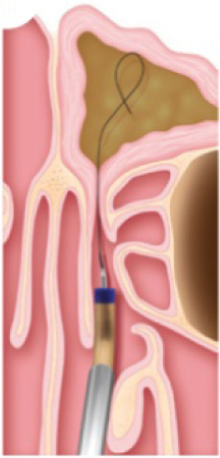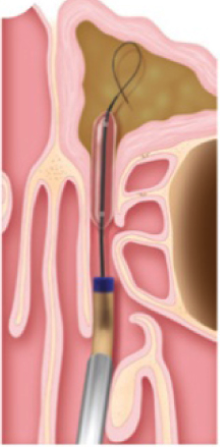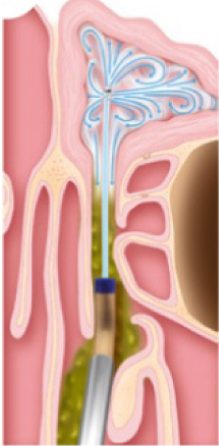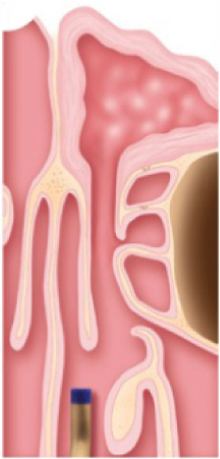MINIMALLY INVASIVE OFFICE PROCEDURES FOR NASAL VALVE COLLAPSE
LATERA – BIOABSORBABLE NASAL IMPLANTS
Latera implants are small resorbable implants that are placed within the soft tissue of the nose to permanently correct nasal valve collapse and improve nasal breathing. The procedure is typically performed in the operating room, but can be performed in the office in select cases.
https://latera.com/latera-
VIVAER LOW TEMPERATURE RADIOFREQUENCY REMODELING OF NASAL VALVES
The Vivaer device low temperature radiofrequency energy to shrink tissue to treat chronic nasal congestion and nasal obstruction due to turbinate hypertrophy, swollen mucosa in the nose, or due to nasal valve stenosis. This is a unique minimally invasive solution that is low risk and can produce durable relief of nasal obstruction in qualifying patients.
https://aerinmedical.com/for-patients/
MINIMALLY INVASIVE OFFICE PROCEDURES FOR CHRONIC EUSTACHIAN TUBE DYSFUNCTION
BALLOON DILATATION OF EUSTACHIAN TUBES (ACCLARENT AERA)
Balloon dilatation of the eustachian tubes is a brief office based or operating room procedure that can permanently reduce symptoms of eustachian tube dysfunction in qualifying patients. This procedure has a proven track record and is commonly used to address chronic or recurrent middle ear effusions, congestion or popping in the ears and inability to clear the ears when barochallenge occurs (such as when flying on an airplane or scuba diving).
MINIMALLY INVASIVE OFFICE PROCEDURES FOR CHRONIC SINUSITIS
BALLOON SINUPLASTY (ACCLARENT)
Balloon Sinuplasty is a new technique in sinus surgery that is now available on the Treasure Coast at Vero ENT Associates. Dr. Livingston, Dr. Baggett and Dr. Jepsen have extensive experience performing Balloon Sinuplasty and have been using this technology for the better part of a decade. Balloon sinus dilatation procedures can be performed both in the Vero Beach office, under local anesthesia, or in the operating room, in conjunction with traditional sinus surgery techniques. Procedures performed under local anesthesia typically afford patients a short, uncomplicated recovery period, with little or no time off from normal activities.
Rather than the use of endoscopic instruments such as microdebriders and forceps, surgeons can now use balloons to dilate the sinus openings called Balloon Sinuplasty. This technique is similar to angioplasty, which is the use of balloons to open blocked blood vessels.
Balloon Sinuplasty can be an effective procedure for patients with chronic sinusitis or those looking for relief from other uncomfortable sinus pain symptoms. This is a less invasive procedure than conventional sinus surgery that allows patients to get back to their daily lives more quickly.
Steps involved with Sinus Surgery and Balloon Sinuplasty
Step 1. A balloon catheter is inserted into the inflamed sinus.

Step 2. The balloon is inflated to expand the sinus opening.

Step 3. Saline is sprayed into the inflamed sinus to flush out the pus and mucus.

Step 4. The system is removed, leaving the sinuses open.

When the sinus balloon is inflated, it restructures and widens the walls of the sinus passageway while maintaining the integrity of the sinus lining.
https://www.jnjmedicaldevices.com/en-US/treatment/balloon-sinuplasty
TRUDI INTRAOPERATIVE IMAGE GUIDANCE
The latest opearative computer localization technologies are employed in conjunction with balloon sinuplasty tools and traditional sinus surgery techniques to improve safety and efficiency of performing sinus surgical procedures in the office and operating room
https://www.jnjmedicaldevices.com/en-US/procedure/navigation
OFFICE BASED ENDOSCOPIC SURGERY FOR LIMITED SINUSITIS AND NASAL POLYPS
Traditional Functional Endoscopic Sinus Surgery (FESS) techniques and tools are used in the office with local anesthesia to perform limited nasal and sinus procedures using local anesthesia, without the need to undergo general anesthesia.
MINIMALLY INVASIVE OFFICE PROCEDURES FOR CHRONIC RHINITIS
CLARIFIX
The Clarifix procedure, also referred to as “cyroablation of the posterior nasal nerves”, is a
brief, low risk procedure performed in the office or operating room to reduce symptoms of
chronic rhinitis that are refractory to common methods of medical management such as
medications or allergy treatment. This proven procedure can reduce vasomotor nasal
symptoms such as watery nasal drainage and congestion in about 80% of patients. The
procedure uses a cryotherapy wand to superficially freeze overactive autonomic nerve branches
in the back of the nasal cavity.
MINIMALLY INVASIVE OFFICE PROCEDURES FOR NASAL OBSTRUCTION
COBLATION TURBINATE REDUCTION (SMITH & NEPHEW)
Coblation is a tool that uses a special bipolar device to ablate and suction evacuate tissue
from the turbinates in the nose. This is a quick, minimally invasive, low risk, durable solution
for nasal obstruction in qualifying patients.
VIVAER LOW-TEMPERATURE RADIOFREQUENCY REDUCTION OF TURBINATES
The Vivaer device low temperature radiofrequency energy to shrink tissue to treat chronic
nasal congestion and nasal obstruction due to turbinate hypertrophy, swollen mucosa in the
nose, or due to nasal valve stenosis. This is a unique minimally invasive solution that is low risk
and can produce durable relief of nasal obstruction in qualifying patients.
https://aerinmedical.com/for-patients/
OFFICE SURGICAL TURBINATE REDUCTION
Surgical turbinoplasty with the emplyment of a microdebrider device can be useful to treat
nasal obstruction in the office in patients that have severely enlarged turbinates.
RELIEVA BALLOON SEPTOPLASTY (ACCLARENT)
The Relieva Nasal Dilatation System employs a minimally invasive balloon device to straighten
the nasal septum, outfracture and compress the turbinates to improve the nasal airway and
improve nasal breathing. The procedure is brief and for many patients a viable alternative to
undergoing nasal surgery in the operating room under anesthesia.
